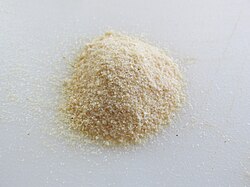Onion powder

Onion powder is dehydrated, ground onion used as a seasoning.[1] It is a common ingredient in seasoned salt and spice mixes,[1] such as beau monde seasoning.[2] Some varieties are prepared using toasted onion.[1][3] White, yellow, and red onions may be used.[1] Onion powder is a commercially prepared food product that has several culinary uses. Onion powder can also be homemade.[4]
Onion salt is a spice preparation using dried onion and salt as primary ingredients.
Commercial production
Commercial onion powders are prepared using dehydration, freeze-drying, vacuum-shelf drying and flow drying.[5] Some commercial onion powders are irradiated as a treatment against potential microbial contamination.[6] It readily absorbs water upon contact, so commercial varieties may be packaged in airtight containers with a liner atop the container.[7] Onion powder with a moisture content of 4–5 percent is prone to caking when stored in warmer environments, with increased temperatures corresponding to a shorter time for the occurrence of caking.[8] It is generally accepted that commercial onion powder is around ten times stronger in flavor compared to fresh onion.[7]
Onion salt
Early commercial preparations of onion salt were simply a mixture of onion powder and salt.[9] An example ratio for earlier commercial preparations is one part salt to every five parts of dehydrated onion.[9] Contemporary versions typically utilize dried granulated onion and salt and usually include an anticaking agent.[10] The salt may help prevent the loss of onion flavor in the mixture by reducing the evaporation of onion oil.[9] The development of commercial onion salt preparations included formulating products that reduced the strong odor of onion in the product and on the breath of consumers who eat it.[9]
Commercial preparation of onion salt involves the testing and sorting of onions by the degree of onion flavor they have, as flavor constituents can vary considerably among various onion varieties.[9] This is done before mixing to produce a consistent final product.[9] Some commercial onion salt preparations are never touched by human hands, as the stages of processing are all performed using automated processes.[9]
Culinary uses
Onion powder may be used as a seasoning atop a variety of foods and dishes, such as pasta, pizza, and grilled chicken. It is a primary ingredient in beau monde seasoning.[2] and is sometimes used as a meat rub.[1] Onion powder is also an ingredient in some commercially prepared foods, such as sauces, soups,[11] and salad dressings. Additionally, it can be used in various recipes like burgers or meatloaf.[citation needed]
Onion salt is used as a seasoning on finished dishes[9] and as an ingredient in many types of dishes, such as meat and vegetable dishes, casseroles and soups.[citation needed]
See also
- Celery powder
- Celery salt
- Chili powder
- Garlic powder
- Garlic salt
- List of culinary herbs and spices
- List of onion dishes
- syn-Propanethial-S-oxide, the molecule that gives onions and onion powder their strong flavor.
References
- ^ a b c d e Engineers, N.B.C. (2015). The Complete Book on Onion & Garlic Cultivation with Processing (Production of Onion Paste, Flakes, Powder & Garlic Paste, Powder, Flakes, Oil). Asia Pacific Business Press. pp. 169–175. ISBN 978-81-7833-159-1.
- ^ a b Whaley, E. (1998). Mrs. Whaley Entertains: Advice, Opinions, and 100 Recipes from a Charleston Kitchen. Algonquin Books. p. 117. ISBN 978-1-56512-782-1.
- ^ Lusas, E.W.; Rooney, L.W. (2001). Snack Foods Processing. CRC Press. p. 510. ISBN 978-1-4200-1254-5.
- ^ Deming, Linda (August–September 2014). "Homemade Onion Powder". Mother Earth News. Retrieved September 18, 2015.
- ^ Debnatha, Sukumar; Hemavathya, J, Bhat, K.K (September 2002). "Moisture sorption studies on onion powder". Food Chemistry. 78 (4): 479–482. doi:10.1016/S0308-8146(02)00161-9.
{{cite journal}}: CS1 maint: multiple names: authors list (link) - ^ Rabinowitch, H.D.; Brewster, J.L. (1989). Onions and Allied Crops: Biochemistry Food Science Minor Crops. Taylor & Francis. p. 80. ISBN 978-0-8493-6302-3.
- ^ a b Heath, H.B. (1981). Source Book of Flavors: (AVI Sourcebook and Handbook Series). Springer. p. 154. ISBN 978-0-87055-370-7.
- ^ Water Activity: Theory and Applications to Food. Ift Basic Symposium. Taylor & Francis. 1987. pp. 93–94. ISBN 978-0-8247-7759-3.
- ^ a b c d e f g h Coffee and Tea Industries and the Flavor Field. Spice Mill Publishing Company. 1914. p. 77.
- ^ Panda, H. (2010). Handbook on Spices and Condiments (Cultivation, Processing and Extraction). Asia Pacific Business Press Inc. p. 74. ISBN 978-81-7833-132-4.
- ^ "Why onions can cause more than tears". BBC News. February 10, 2015. Retrieved September 18, 2015.
Further reading
- Granovskaya, R.Y.; Korneva, L.Y. (1973). Quality Variation of Onion Powder During Storage in Polymer Packaging. Defense Technical Information Center. 5 pages.
